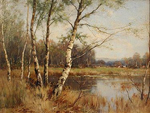
The Disenfranchised
"Inebriate of air - am I -" (l.5)
"207" [214] (1861)
Points
for Reflection
E. B. Browning's "The Runaway Slave at Pilgrim's Point" (1846; 1848, 1850)
- EBB originally opened this poem with four italicized stanzas voiced by the narrator's male lover. Would you like to hear his perspective too, or is the female narrator's voice the one on which we should focus?
- what central tension does E.B.B. establish in stanza one?
- who constitutes the auditor for this poem, in its opening? At what point does the intended auditor change?
- what provides the subject matter of the one song the narrator knows, and at what points does she prove unwilling to sing it?
- is E.B.B. concerned more with creating a sense of high fidelity (realism) in this poem, or with shaping an emotionally and aesthetically effective polemic?
- can we deduce what happens to the narrator's lover?
- how does the narrator's devotion to God change in response to the abuse she received at the hands of her owners?
- do lines 138-40 constitute an indictment of miscegeny?
- what happens to the narrator's child, and why?
- unpack the paradox of lines 146-47.
- consider the central metaphor of stanza twenty-three: if "fruit" is the vehicle (ground), what is the tenor (figure)?
- what is the dominant tone of stanza twenty three? Celebratory? Bitter? Something else?
- how do the angels respond (at least, in the imagination of the narrator) to the narrator's surprising actions?
- is the reader encouraged to either pity or scorn the narrator?
- what are the five men who find the narrator preparing to do (l.211)?
- do lines 212-15 constitute a curse or blessing?
- towards what action is the narrator calling her fellow slaves (ll.229-32)?
- should the reader agree with the narrator that she is "not mad" (l.218), but perfectly sane?
- what does the narrator mean by the statement, "Our wounds are different" (l.239)?
- does the narrator curse her captors in the poem's close?
R. Browning's "Deaf and Dumb: A Group by Woolner" (1864)
- pay close attention to the adjectives (incl. past participles) that Browning uses throughout this poem.
- do you applaud Browning's choice to use a scientific analogy (l.1-3) to make his point about the beauty that can arise from irregularity?
- whose love is first "vexed," then successful at "wreak[ing] its insuppressive sense" (ll.5-6) across the face?
- do you agree that the eyes can communicate as much as--even more than--the lips?
- examine online some photos of the sculpture referenced in Browning's poem. Is the tone of the poem similar to the tone established by the sculpture?
E. Dickinson's "320" [258]
- does the phrase "Slant of light" (l.1) and the given season (winter) suggest an outdoor or indoor experience?
- does the synaesthetic simile comparing light with sound (ll.1-4) suggest that church is a physically or spiritually uncomfortable place?
- does "heavenly" in l.5 denote the agent of the described hurt, or the nature/character of the hurt?
- what might the "Slant of light" (l.1) represent, and what type of pain is it causing in the narrator? What is Dickinson attempting to express?
- compare the narrator's attitude towards despair with that found in STC’s “Dejection: An Ode,” Keats’s “Ode on Melancholy,” and Hopkins’s “Carrion Comfort."
- is the departure of Despair a good thing?
E. Dickinson's
"620" [435]
- does this poem echo or interrogate the core theses of the following works?
- Michel Foucault's Madness and Civilization (1961)?
- John Stuart Mill's On Liberty (1859)
- be ready to explain the apparent paradoxes in lines one and three.
- what is Dickinson suggesting about the popular majority?
M. Arnold's "Stanzas from the Grande Chartreuse" (c.1852; 1855)
- why is the narrator of this poem (who speaks with Arnold's own voice) surprised to find himself at this Carthusian monastery in the Alps (l.66)?
- why is the narrator crying (ll.85-90)?
- explain the irony threaded into lines 91-108.
- does the narrator value the “mood of sadness” (l.153) spun by the Romantic poets Byron and Shelley?
- to what purpose does Arnold put the two epic similes found in lines 80-84 and 169-92?
P. L. Dunbar's "We Wear the Mask" (1897)
- identify the lie perpetuated by the narrator and his kin, and the cost of this lie.
- are the tongues and lips of those who wear the mask as complicit in this ongoing act of deception as are their eyes and cheeks?
- who benefits from such ongoing subterfuge?
- why does the observer--the world--take the mask for the real thing?
- does Dunbar's poem seek succor in the same Divine source to which the narrators of Hopkins' dark sonnets turn?
- to what might the "clay" of line thirteen refer?
Zitkála-Šá's "America's Indian Problem" (1921)
- how does DeSoto turn Christianity into an excuse for subjugating North America’s indigenous population?
- what does Zitkála-Šá find ironic about European immigrants use of force in the New World?
- in what way are native Americans “legal victims”?
- what happens to the reports prepared by a congressional commission looking into the standing of Native Americans?
- for what reasons did the United States government disenfranchise Native Americans for so many years, according to Zitkála-Šá?

Birches by the Marsh (c.1890)
James Edward Grace
Dr. Paul Marchbanks
pmarchba@calpoly.edu
![]()
